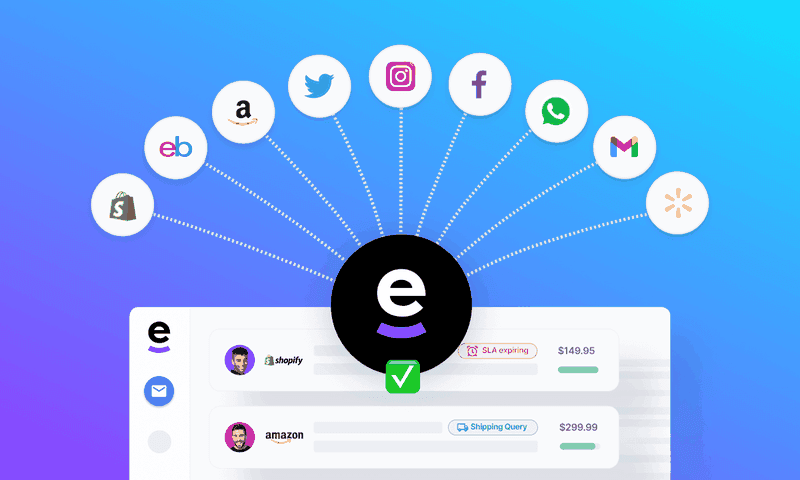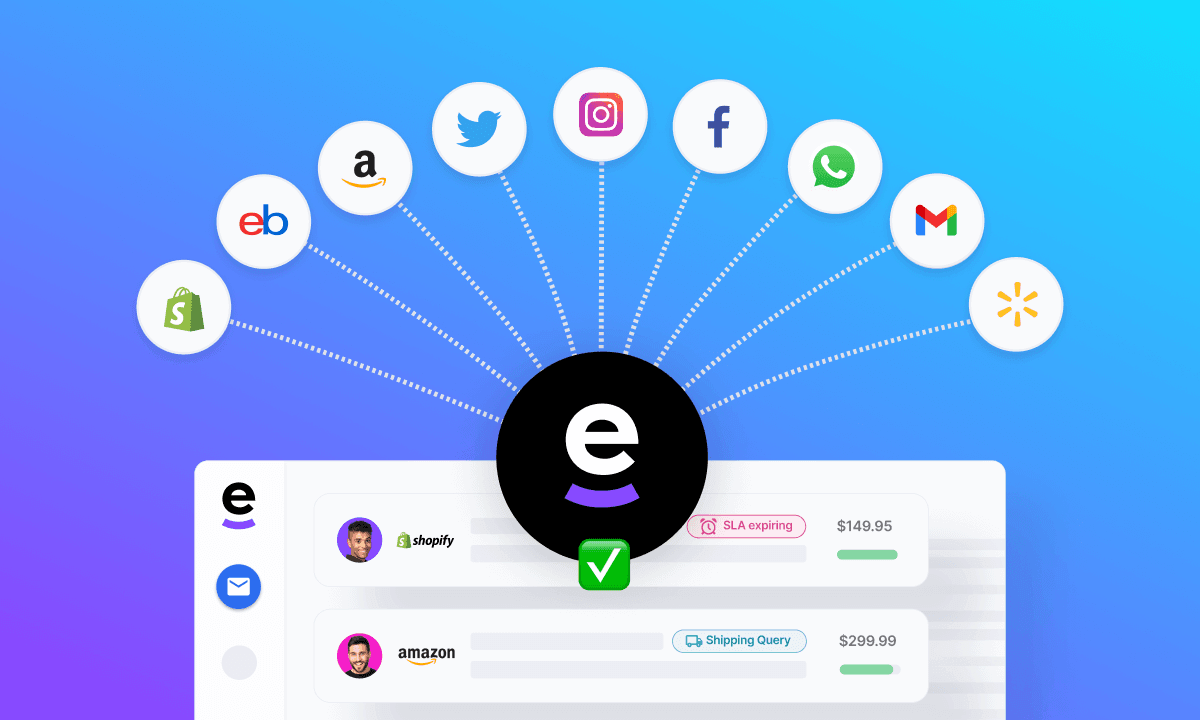Does expanding your eCommerce business into selling in multiple channels seem like a daunting task? With the right multichannel growth strategies in place, it can be a great way to achieve quick growth.
Here are three tips to help you get started.
● Take a strategic approach: Before expanding into any new marketplaces, take the time to develop a well-thought-out strategy. This will ensure that your efforts are focused and that you have a plan for overcoming any challenges that may arise.
● Do your research: Make sure you have a good understanding of each marketplace before launching there. What are the unique selling points (USPs) of that marketplace? What is the competition like? How do shoppers in that marketplace behave?
● Be prepared for setbacks: Unfortunately, no strategy is perfect, and there will likely be some bumps along the way. Have contingencies in place so you can quickly address any issues that arise.
By following these tips, you can set your eCommerce business up for success when expanding into new marketplaces.
If you need help getting started, eDesk is here to assist. We are the leading provider of eCommerce customer support software, and our platform is designed to help businesses succeed in multiple marketplaces.

Ways to expand your eCommerce business
There are many ways to increase eCommerce growth, including using social media marketing, email marketing, A/B testing, and retargeting. Of course, each method has its own advantages and disadvantages, so it’s important to choose the ones that will work best for your business.
Despite your options, there is one clear winner; taking a multichannel approach. Creating a profile and listing your products on marketplaces like Amazon, eBay, and Etsy can help you reach a larger audience and boost sales.
There are also downsides to this, such as supply chain issues, brand confusion, and increased customer service demands. However, they can be solved with eDesk’s many customer service tools.
In this article, we will talk about multichannel growth strategies and common problems you may run into, as well as of course, solutions to these problems.
10 common approaches to eCommerce growth
1. Expand your product offering
The first approach to consider is expanding your product offering. This can be done in a number of ways, such as adding new products or categories, targeting new markets, or expanding into new channels.
There are many benefits to expanding your product offering. For one, it can help you stay competitive and up to date with the latest trends. Additionally, it can help you attract new customers and boost sales. And finally, it can help you diversify your business and reduce your reliance on any one channel or market.
There are also some risks associated with product expansion. For one, it can be difficult to manage multiple product lines effectively. Additionally, you need to make sure that your products are a good fit for the new marketplaces you’re targeting. If they’re not, you could end up selling products that no one wants to buy.
2. Enter new markets
When expanding into new markets, there are a number of things to consider. On the one hand, entering new markets can be a great way to grow your business. By tapping into new geographies or demographics, you can expose your brand to new customers and increase sales.
On the other hand, you need to make sure that you have a good understanding of the marketplaces you’re targeting and that your products are a good fit. If you don’t do your research, you could end up making costly mistakes.
3. Increase online visibility
Another approach to growing your eCommerce business is to increase your online visibility. This can be done through a number of different channels, such as search engine optimization (SEO), social media marketing, and email marketing.
There are a number of benefits to increasing your online visibility. Extra visibility can help you reach new customers who are searching for your products online. Additionally, it can help you build relationships with potential customers and create brand awareness. Finally, it can help you drive traffic to your website and increase sales.
There are also some risks associated with increasing your online visibility. It can be time-consuming and expensive. Additionally, if you don’t do it correctly, you could end up damaging your brand’s reputation.
4. Optimize your website for conversions
Another approach to growing your eCommerce business is to optimize your website for conversions. This means making sure that your website is designed in a way that encourages visitors to take the desired action, whether that’s making a purchase, signing up for a newsletter, or downloading a product.
There are a number of benefits to optimizing your website for conversion. For one, it can help you increase sales and grow your business. Additionally, it can help you improve the ROI of your marketing campaigns. Finally, it can help you create a better user experience for your visitors.
There are also some risks associated with optimizing your website for conversion. It can be expensive and time-consuming, meaning you’re taking away resources that could be better used elsewhere in your business. Additionally, if you don’t do it correctly, you could end up driving away potential customers.
5. Focus on mobile
The average American spends more than five hours a day on their mobile devices, and that number is only increasing. As a result, it’s no surprise that mobile commerce (mCommerce) is growing at a rapid pace. Retail mCommerce sales hit $359.32 billion in 2021, an increase of 15.2% over 2020. By 2025, retail mCommerce sales should more than double to reach $728.28 billion and account for 44.2% of retail ecommerce sales in the US.
If you’re not focusing on mobile, you’re missing out on a huge opportunity. Make sure your website is responsive and optimized for mobile devices. In addition, consider creating a mobile app to provide an even better customer experience.
By focusing on mobile, you’ll be able to reach more customers and boost your sales, but there are some downsides to consider.
First, developing a webstore and mobile app can be expensive. Not only do you need to hire a developer, but you also need to budget for testing and marketing.
Second, not all customers prefer to shop on mobile devices. Some people still prefer to shop on desktop computers or laptops.
6. Improve customer service

Better customer service can mean more satisfied customers, who are likely to be more loyal and return for future purchases.
Additionally, satisfied customers may be more likely to recommend your business to others. This can lead to increased word-of-mouth marketing and more business.
Achieving this goal can require you to hire more staff but this can often be avoided by investing fit for purpose eCommerce customer support technology and training programs. Additionally, you may need to change your business processes and organizational structure to support better customer service.
7. Invest in social media marketing
Social media marketing is one of the most effective digital marketing strategies out there. Not only does it allow you to connect with your target audience, but it also gives you the chance to showcase your brand’s personality.
Investing in social media marketing will help you reach a larger audience and build relationships with potential and existing customers. Plus, it’s a great way to stay top of mind and keep your brand relevant.
The downsides of social media marketing are that it can be time-consuming and it can be difficult to measure the results. You need to be prepared to invest time and effort into social media if you want to see good results. And, even then, it can be difficult to determine whether your efforts are paying off.
8. Use email marketing to drive sales
Email marketing is another effective digital marketing strategy that can help you reach your target audience and boost sales.
By building a list of subscribers and sending them targeted emails, you can stay top of mind, build relationships, and drive sales. Just make sure you’re not overdoing it with the emails or you risk ending up in the spam folder.
The downside of email marketing is that it can be time-consuming to create and send emails. Plus, if you don’t have a large list of subscribers, you may not see a lot of results from your efforts.
9. Conduct A/B testing to improve conversion rates
A/B testing, also known as split testing, is a method of comparing two versions of a web page to see which one performs better.
You can test anything on your web page, from the headline to the call-to-action button. By testing different elements, you can figure out what works best for your audience and your business.
The downside of A/B testing is that it can be time-consuming and expensive. You need to create two versions of your web page and then track the results to see which one performs better.
Additionally, A/B testing requires a lot of traffic to your website in order to get accurate results. If you don’t have a lot of traffic, the effort may be greater than the benefit.
10. Use retargeting to reach warm leads
Retargeting is a form of online advertising that allows you to show ads to people who have already visited your website.
This is a great way to stay front of mind and increase the chances that those visitors will come back and make a purchase.
The downside of retargeting is that it can be expensive. You need to have a large enough budget to reach a significant number of people. Additionally, retargeting can be intrusive and may annoy some users.
The best approach: using multichannel growth strategies
The multichannel marketing approach offers a great way to grow your eCommerce business. These strategies allow you to reach a large audience of potential customers, and they make it easy for buyers to find and purchase your products.
Additionally, multichannel marketplaces provide a lot of valuable marketing and selling features that can help you sell more products and grow your business. They are a great way to diversify your sales channels and increase your online presence.
However, it’s not all sunshine and rainbows. There can be challenges to selling on multiple channels and marketplaces. Here are some examples of businesses that have tackled these issues.
1. Managing Supply Chains

One of the biggest problems you’ll face when selling on multichannel marketplaces is managing your supply chain and managing inventory across several different platforms. This can be difficult and time-consuming, and it can lead to stockouts and order fulfilment delays.
The solution
To overcome this problem, you need to develop a solid inventory management system. This system should track inventory levels across all of your sales channels, and it should also automate order fulfilment and shipping. By automating these processes, you can minimize the risk of stockouts and order fulfilment delays.
2. Brand confusion
When selling on multiple marketplaces, it’s important to ensure that your brand is well-represented across all of them. However, there’s a risk that buyers may become confused about which platform is the official source for your products. This can lead to lost sales and decreased brand loyalty.
The solution
To avoid this problem, you need to create a strong branding strategy for your marketplace presence. Your branding should be consistent across all of your channels, and it should clearly communicate which platform is the official source for your products. You may also want to consider developing unique marketing campaigns specifically for each channel.
3. Increased marketing costs
Another problem you’ll face when selling on multiple channels and marketplaces is increased marketing costs. When you sell on multiple platforms, you’ll need to invest in marketing campaigns for each one. This can be costly, and it may not be feasible for small businesses.
The solution
To overcome this problem, you need to reconsider your marketing strategy. Make sure you’re targeting the right audience, and use data from your marketing campaigns to optimize your spending. Additionally, consider using marketing automation tools to help you manage your campaigns and reduce your costs.
4. Language barriers can be a huge issue
When selling in multiple geographies, you’ll need to deal with the fact that some buyers may not speak your language. This can be a major problem if you’re trying to sell internationally.
The solution
Overcoming this challenge could involve hiring local customer service representatives or those who are fluent in the languages of your target markets, but this can be costly and difficult to manage. Alternatively, multilanguage customer support solutions can save you time and money. Additionally, make sure your listings are configured to display prices in the local currency.
5. Customer service demands

Another problem you’ll face when using multiple sales channels and marketplaces is the increased demand on your customer service team. When you sell on multiple platforms, you’ll have to deal with customer service issues on all of them. This can be time-consuming and expensive, and it may require you to hire additional staff.
The solution
Invest in good customer service tools and systems that will help you to automate routine customer service processes, and allow you to manage customer queries from multiple channels in one location.
6. Managing multichannel customer communications
When you sell on multiple marketplaces, you’ll need to deal with customer communications on all of them. This can be a challenge, as you’ll need to keep track of conversations on multiple platforms. Additionally, buyers may become frustrated if they have to contact you on different channels for different issues.
The solution
To overcome this problem, invest in good customer communication management tools, which make it easy for you to communicate in real time, prioritize urgent support tickets, automate replies where appropriate, and turn great customer experiences into great reviews.
Final thoughts
Selling on multiple channels and marketplaces is the easiest way to increase your business’s exposure to a wider audience. Our customer support solutions can help you manage all of your customer communications in one central location, reduce your costs and boosts your reputation.
Contact us today to learn more about how we can help you grow your online business with extraordinary customer service.


